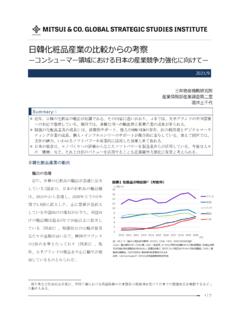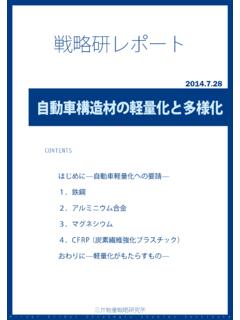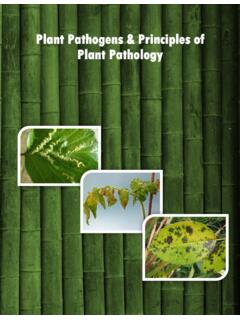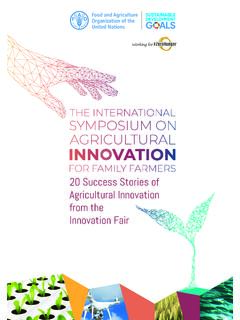Transcription of Cultured Meat Production Technology: Challenges
1 Mitsui & Co. Global Strategic Studies Institute Monthly Report November 2020. Cultured MEAT Production technology : Challenges AND FUTURE DEVELOPMENT. Kazuko Sato Consumer Innovation Dept., technology & Innovation Studies Div. Mitsui & Co. Global Strategic Studies Institute SUMMARY. Meat substitutes are currently gaining attention as a way to overcome the shortage of meat supply against the growing global population and conserve the environment. There are two types of meat substitutes: plant-based meat and Cultured meat. Cultured meat can be artificially produced indoors: therefore, compared with plant-based meat substitutes, Cultured meat is said to have a smaller environmental impact and be less susceptible to the effects of climate change. Production of Cultured meat is faced with technological Challenges in the materials used in Production ( , culture medium) and the method of mass Production .
2 Not only many startups but also large companies have begun efforts to resolve these issues. If a company operates a business related to Cultured meat, it should focus not only on companies producing Cultured meat, but also on those that possess important technologies in the supply chain overall. 1. MEAT SUBSTITUTES. 1-1. Background to increased demand for meat substitutes There are two types of meat substitutes: plant-based meat and Cultured meat. Plant-based meat substitutes are already on the market, and their demand is rising every Although Cultured meat is not yet commercially available, research and development is underway to meet the demand for such as high value- beef. This increase in demand for meat substitutes can be considered from two points of view: response to meat supply shortage and environmental protection.
3 The shortage in meat supply is attributed to the increase in the global population. The world population, which stands at billion people in 2020, is expected to rise to billion by 2050. This population growth is projected to increase the demand for meat times from 2020 to 2050, and the demand is estimated to double, particularly in developing countries where incomes are expected to In terms of agricultural land use, as much as 77% of the total agricultural land is used for livestock breeding or feed cultivation. Further increase in livestock breeding is considered to be unlikely in the face of climate change, which makes it difficult to expand agricultural land. Producing meat substitutes, which requires the use of less land compared to livestock rearing, is expected to resolve concerns about the shortage of meat 1 Plant-based market overview, The Good Food Institute (Last accessed on October 23, 2020, same below).
4 2 Hannah Ritchie, Half of the world's habitable land is used for agriculture, Our World in Data, Nov. 11, 2019. 3 World Livestock 2011 Livestock in food security, FAO. 1. Mitsui & Co. Global Strategic Studies Institute Monthly Report November 2020. From the second point of view environmental protection, Figure 1: Protein conversion efficiency (%). meat substitutes are gaining attention for their high 0 20 40 60 80. Production efficiency. In terms of protein conversion Plan t-b ase d mea t 75. efficiency (the amount of protein obtained in relation to the substitutes amount of protein supplied), even chicken, the most Cultured meat 70. efficient among all livestock, is at , whereas meat Chicke n substitutes (plant-based meat substitutes, Cultured meat). are extremely high at over 70% (Figure 1). Therefore, meat Por k substitutes are considered to be one of the options to obtain Bee f higher output (protein) with lower input (protein such as fertilizers, forage, culture medium), without causing much Source: Prepared by MGSSI based on AT Kearney reports and Our World in Data impact on the environment.
5 A notable new trend is to consider meat substitutes from an animal welfare point of view. From this point of view, the number of livestock animals that can be raised per unit area is now restricted (control on livestock Production efficiency). In addition, an increasing number of consumers are avoiding meat which involves animal slaughter. A survey conducted in Germany and France in December 2019 shows that animal welfare and environmental protection rank high among the reasons favoring meat Against this background, plant-based meat is taking the lead as a meat alternative. However, for the procurement of raw materials, particularly soybeans, stable supply is a concern because climate change may affect it. When compared to plant-based meat substitutes, Cultured meat has the following advantages: 1) it does not need to undergo a growth process lasting over a couple of years; 2) it is less impacted by climate change because it is artificially produced indoors; and 3) it can be produced anywhere as long as the facilities are in place, regardless of the country or region.
6 1-2. Meat substitute Production process and the current status of market entrants As previously mentioned, there are two types of meat substitutes at present: plant-based meat and Cultured meat. Plant-based meat substitutes are produced by cooking existing protein-rich plants, such as soybeans, and then extruding them into a meat shape. For companies, the hurdles to entry into this business are considered low because reusing existing technologies and facilities make Production possible. Beyond Meat, a US startup producing plant-based meat substitutes, became listed in 2019 and started selling its products to Starbucks in China. Another US company, Impossible Foods, provides its products at more than 1,000. restaurants and other businesses in the entire country. Other food giants such as Nestl (Switzerland), Kellogg's (US), and Tyson Foods (US) have also entered or announced their entry into the plant-based meat substitute business.
7 This field is now the focus of attention among not only food companies but also chemicals manufacturers. In Japan, Shin-Etsu Chemical has entered into the manufacturing of additives used for processing plant-based meats. There are still many Challenges , such as recreating the taste and texture of meat and exploring product line-ups (at present, only chicken nuggets and hamburgers are available). Nonetheless, the technology has achieved a level where Production volume can meet market demand and the products can meet market needs. As more improvements are made, further market penetration is expected in the future. Cultured meat refers to meat produced by using artificial cell culture. It is made by growing master cells produced by collecting samples from cattle, pigs, and other livestock. The meat is artificially produced: Except for when cells are collected, existing livestock is not used in the Production processes.
8 Cultured meat is seen as a new field in food products, where livestock meat is recreated without killing farm animals. On the back of this, the number of startups involved in development of Cultured meat is rising year after year and has now reached 60. as of June 2020, compared to four or so in the world in 4 Hanna L Tuomisto (2019) The eco friendly burger, EMBO Rep 20 e47395. 5 Christopher Bryant, Lea van Nek, and Nathalie C. M. Rolland European Markets for Cultured Meat: A Comparison of Germany and France, Foods 2020, 9(9), 1152. 2. Mitsui & Co. Global Strategic Studies Institute Monthly Report November 2020. 2. TECHNOLOGICAL Challenges AND ADVANCEMENT IN Cultured MEAT Production . 2-1. Technological Challenges in Cultured meat Production Cultured meat entails issues such as meat safety and consumers' acceptability.
9 On top of such issues, there are still some Production technology Challenges to be addressed in order for Cultured meat to go on the market. The Production process for Cultured meat can be divided into three parts: cell collection, cell culture, and Cultured meat Production and at each of the parts, the challenge lies in the method. At cell collection, the method of obtaining living cells; at cell culture, the method of developing and mass-producing culture medium and other materials; and at Cultured meat Production , the processing method (Figure 2). A report by Good Food Institute, a US non-profit organization promoting meat substitutes, and many other materials show that the biggest challenge is the method of developing and mass-producing culture Even startups developing Cultured meat do not carry out the entire process of Production .
10 Many companies have come up now that specialize in the method of developing and mass-producing culture medium (Figure 3). This indicates that even though many have pointed out Challenges regarding the method of developing and mass-producing Cultured fluid, the optimal solution has not yet been found. 2-2. Culture medium development technology Culture medium generally contains amino acids, vitamins, inorganic salt, glucose, growth factors (hormones), and other nutrients required for cell growth . Of these, growth factors are the most important content of culture medium. It is generally said that cells cannot multiply in the absence of growth factors; therefore, the use of 6 An analysis of culture medium costs and Production volumes for cultivated meat, Good Food Institute 3. Mitsui & Co. Global Strategic Studies Institute Monthly Report November 2020.














